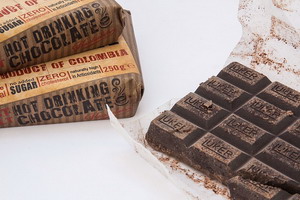Ah the delicious wonder that is chocolate. In its pristine form chocolate is a fabulous health food. It contains many phytochemicals that support the body including flavonols that fight inflammation and brain degeneration and theobromine which stimulates the brain while also calming it and strengthens tooth enamel. The cocoa butter in chocolate contains polyphenols which fight skin aging by improving tone, hydration, and elasticity as well as decrease atherosclerosis in our arteries.
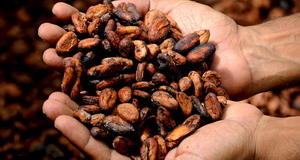
Chocolate has been used as a beverage for over 4000 years. It was considered so precious that it was used as a form of currency in the Aztec empire. Back then a turkey was valued at 100 cacao beans while a ripe avocado was three beans. You even had to pay your taxes with cacao beans.
Cacao beans are very bitter naturally and have to be fermented before even becoming tolerable.
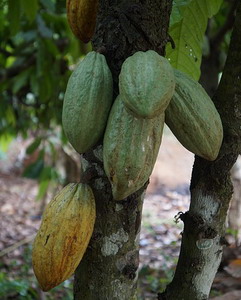
The beans are found in big seed pods bigger than your hand growing right out of the cacao tree trunk. Mature pods are harvested and smashed by foot and left to ferment for some time. Then the beans are extracted, washed, roasted and the outer shell cracked away leaving the inner “nut.” This nut is broken up into tiny pieces called nibs and sold to processors to be made into chocolate. You can buy these nibs for consumption like those I have here. They are still pretty bitter, but many people like them.
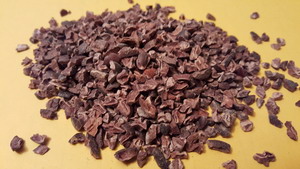
The nibs are ground into chocolate liquor which might then be separated in a hydraulic press into cocoa butter and cocoa solids. The final cocoa butter is a hard solid at room temperature, but will melt at body temperature. Cocoa powder will be a light brown and still quite bitter. Most cocoa powder in this country has been treated with alkalizing agents to neutralize the acids and produce a milder, smoother flavor and a darker color – called Dutch processing. Unfortunately this process also destroys most of the healthful flavonols that act as antioxidants and protect the brain.
Dutch processing is just the beginning of the degeneration of this healthful food into the junk food we mostly eat today. The big shift in the use of chocolate came when Europeans added sugar to it. Until then it was used primarily as a bitter beverage like coffee. But when Dutch processing reduced the bitterness, then other clever folks added sugar to it and started making it into candy. Before long the chocolate industry was formed. Real chocolate used to be hard to find, but now very dark 90% or 80% cocoa bars are readily available.
The big problem I have encountered is that almost all chocolate still contains sugar. There are some “sugar free” chocolates that simply have sugar alcohols like maltitol in them that are mostly good for creating gas and diarrhea. They are better than nothing, but still… A few years ago a company named Lily’s started making a chocolate sweetened with stevia and inulin. This was a great idea, but the end product just didn’t have any taste. Why hasn’t anybody created a great tasting chocolate without sugar?

The last few weeks I have been trying to do just that. I am finding out that it is not an easy process. Chocolate is a funny substance. It is a crystal. I know this sounds weird, but it gets even weirder. Depending upon just what temperature you process the chocolate at, it will form into six different kinds of crystals. The type you want is type 5 which melts at 93 degrees. Other crystal forms of chocolate melt at lower temperatures, but are too soft and crumbly to make good chocolate bars. To make a good chocolate you first have to heat it to 113 degrees to melt all forms of the chocolate crystals then slowly lower the temperature to 81 degrees and agitate the chocolate to help it form the type 5 crystals. It makes it easier if you add some chopped up chocolate that already is a type 5 to act as seed crystals while you cool the liquid chocolate down from 113 degrees to 81 degrees. At 81 degrees you can add sweeteners and flavors to be incorporated into the final product. This whole heating and cooling process is called tempering the chocolate.
I have been experimenting with different sweetening agents and filling agents. Chocolate candies rarely contain that much chocolate. In fact cheap chocolates might have as little as only 7% chocolate in them. The rest is sugar and other stuff. As I experimented with pure chocolate by mixing pure cocoa butter with cocoa powder and a touch of stevia, the final product seemed waxy in the tongue because of the high cocoa butter fat content. Cocoa butter chips feel and look like candle wax. Yet when I add other things to the mix, the feel would become gritty or chalky. This is because I do not have the equipment to perform one of the steps in making commercial chocolate – conching. This is a slow grinding process that makes a very fine texture of the cocoa powder and sugar – too fine to feel the grit on the tongue. Very fine chocolates can be conched up to 72 hours.
Never the less I pushed ahead. I created many samples and my staff and friends got to rate them. The next problem I encountered was that each person liked a different sample. Finally two people agreed on one version over the others, so I went forward. That version used glycerin and stevia as the sweetener. My second choice used a fiber called Vita fiber plus stevia. Both would produce a good solid chocolate bar with a good snap and some nice sweet taste while still having real chocolate flavor.
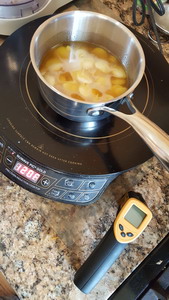
My process: I melt cocoa butter chips over a low heat (I use induction heating because I can set the temperature) while frequently checking the actual temperature with a digital thermometer. When it gets up to about 116 degrees, I turn off the heat and add chopped cocoa butter chips to the melted cocoa butter. These chopped pieces serve as seeds for forming the right type of cocoa butter crystals. I used a hand blender to mix these in, but stirring is all that is necessary. Once the temperature gets down to about 85 degrees, I would blend in the cocoa powder – about ¼ as much as the amount of chips. I then carefully added tiny amounts of pure stevia powder and mixed until the desired sweetness was
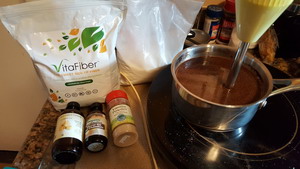
achieved. Next I added in either the glycerin or Vita fiber plus vanilla powder and maybe a flavoring designed for chocolates. You have to use special flavorings that contain no water, as any water at all will ruin the chocolate by causing it to seize – solidify into a soft mass.
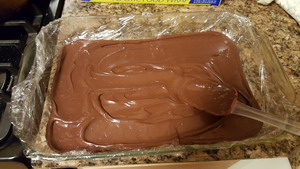
With the chocolate still very liquid it was ready to form into candy. I lined a glass pan with 2 layers of plastic wrap and poured in the chocolate. Over top I added chopped nuts or unsweetened coconut shreds. Another layer of chocolate over this and the whole pan is set aside to crystallize into a real chocolate candy. Don’t try to hurry this step along by putting the pan into a cold place. Let it set at room temperature for the best outcome. The bonus tip I discovered is that it helps to pre-cut the chocolate after it has firmed up, but is not hard yet. Once it is hard, trying to cut it is almost impossible and results in lots of broken shards of chocolate all over the
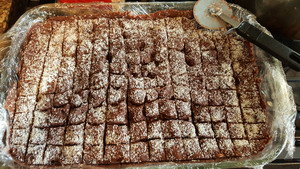
kitchen. I found that a pizza cutter is ideal for this purpose.
So there you have it. Truly sugar free chocolate that actually tastes like chocolate. You could pour this chocolate into molds to form chocolate bars or other shapes, or you could put it into a pan that keeps it at 81 degrees while you dip things into it like dried fruits or little peanut butter balls. Christmas gifts here we come!
